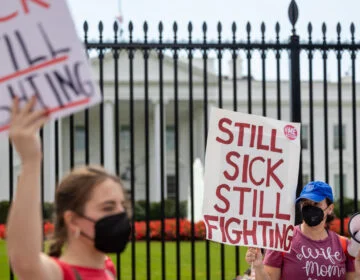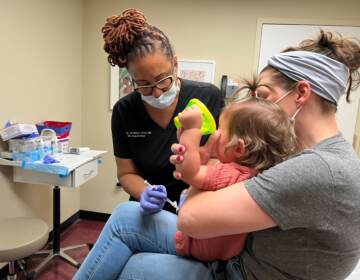What is ‘flurona’? Why are people talking about it now?
Co-infections sometimes happen. This time, they’ve sparked a clever nickname.

In this Nov. 24, 2020, file photo, Dr. Shane Wilson performs rounds in a portion of Scotland County Hospital set up to isolate and treat COVID-19 patients in Memphis, Mo. (AP Photo/Jeff Roberson, File)
Ask us about COVID-19: What questions do you have about the coronavirus and vaccines?
Word about “flurona” is spreading these days, much like the two things that inspired the nickname — the coronavirus and the influenza virus. It’s been mentioned a lot in the news and social media since two young pregnant women in Israel tested positive for both infections.
“Flurona” has only recently captured public attention, but being infected with the two viruses simultaneously isn’t new: A case was reported as early as February 2020 in the United States. Co-infections may increase slightly now, though, as people are more socially active than they were earlier in the pandemic. So far, cases have been confirmed in the United States, Israel, Brazil, the Philippines, and Hungary.
What is flurona?
It’s a name made up to describe the situation in which a person has a coronavirus infection and the flu at the same time.
Getting more than one virus at a time is a “garden-variety normal thing,” said Dr. Thomas Fekete, a professor of medicine and microbiology and immunology at the Lewis Katz School of Medicine at Temple University.
Dr. Judith O’Donnell, the division chief of infectious diseases at Penn Presbyterian Medical Center, said it’s not something to be overly concerned about.
“The name seems to suggest that the viruses have somehow combined — and that’s not the case. It’s just that a person may get infected with two respiratory viruses at the same time or in short succession,” O’Donnell said.
“It’s rare, but it’s not surprising that during a typical influenza season, which here in the northern hemisphere is right now during the winter months, that you will see multiple respiratory viruses circulating at the same time, and that people can get infected with more than one respiratory virus at the same time.”
How common could it be?
Prior to the pandemic, getting two viruses at once was known to happen.
“When we did these respiratory viral panels, the ones that are commercially available in the last five or six or seven or eight years, I’d say of the ones that were positive, probably 10% had more than one virus positive. So it’s definitely not super rare,” Fekete said.
Last year, flu cases declined because people were isolating more to avoid getting COVID-19. However, some hospitals around the world did see some cases of patients getting both viruses, Fekete said.
“We’re seeing a lot more flu in the country. So it’s very probable that we’ll have a lot of people with more than one virus, including maybe the mix of influenza and coronavirus. So nothing unusual or surprising,” he said.
How serious is it?
There isn’t a single answer to that question, the health experts say, and it depends on the person.
For the most part, you can expect a relatively mild infection. The exceptions though are people who are unvaccinated for COVID-19 and the flu, as well as older people, and people who are immunocompromised, O’Donnell said.
People with two respiratory viruses often get symptoms of having just one virus, Fekete said.
“What I read about these combinations of influenza and coronavirus, for the most part, they behaved like you’d expect them to, which is to say, some people got very sick, some people weren’t that sick, and the symptoms were the kind of symptoms you expect, whether they were respiratory symptoms like coughing, sneezing, runny nose or they were more systemic like fever and muscle aches and headaches,” he said.
“So in that sense, they kind of behave like either one or both, but I don’t think they were dramatically different or in any way unusual. We’ll have to see more cases to see if there is something unique about this combination … But so far, we don’t know that much about it. Here at Temple, we’ve only diagnosed a few of them and nothing jumps out as having been particularly alarming or unusual there either.”
How is it treated?
Health experts say individuals with both viruses would be treated in the same way they would if they had either one alone.
There aren’t a lot of treatments for COVID-19, particularly for mild cases. Steroids are available for patients with moderate to severe illness; Remdesivir, an intravenous drug, is available for patients admitted to the hospital; and monoclonal antibodies are offered to patients at risk for serious illness early on in their diagnoses. Monoclonal antibodies are not as effective against the omicron variant. Hospitals hope to receive the recently authorized Pfizer and Merck antiviral pills in a couple of weeks.
There also are only a few medications for influenza, including oseltamivir, also known as Tamiflu, and baloxavir, also known as Xofluza, both available by prescription.
How do I avoid ‘flurona’?
The best practice is to get your COVID-19 vaccine and booster and a flu shot, the health experts say. They also advise against large gatherings and suggest wearing masks indoors.
You can get multiple vaccines at the same time. If you decide to get them separately, allow for a couple of weeks in between because you might not get the desired immune response if you get the other shot too soon.
“I’m just maybe kind of like an old-fashioned guy — just kind of suck it up, side effects aren’t all that bad, and the coronavirus vaccine side effects are probably worse than the flu vaccine, so adding the flu vaccine is probably not that big of a deal,” Fekete said.
“Most clinics will do that,” he said, “they’ll give you one on one arm, one on the other arm, and send you home, and you’ll be miserable for a day or two, and then you’re fine. But I would say, let’s get them into you now, rather than kind of keep finding excuses not to do them, because you know how people are, including me, ‘I’ll do it later. I’ll do it later. I’ll make a call in a week.’ And then you forget, or you can’t get an appointment right away, and all of a sudden you didn’t do it.”
The Centers for Disease Control and Prevention has said that it’s safe to receive other vaccines at the same time as your COVID-19 vaccine or booster. O’Donnell said it comes down to a personal decision about whether you want to get them over with or avoid side effects.
“There’s no decrease in their effectiveness if you were to give them both at the same time, and your providers understand how to deliver those vaccines,” she said.
“Side effects have been quite variable from person to person. Some people have reported that after their booster shot, they’ve felt as many side effects as they did after their first or second shot. Others have said that the booster shot did not have as many side effects as they had with their second shot of their mRNA vaccine. So it’s really an individualized experience — it’s hard to predict.”

Saturdays just got more interesting.
WHYY is your source for fact-based, in-depth journalism and information. As a nonprofit organization, we rely on financial support from readers like you. Please give today.





![CoronavirusPandemic_1024x512[1]](https://whyy.org/wp-content/uploads/2020/03/CoronavirusPandemic_1024x5121-300x150.jpg)


